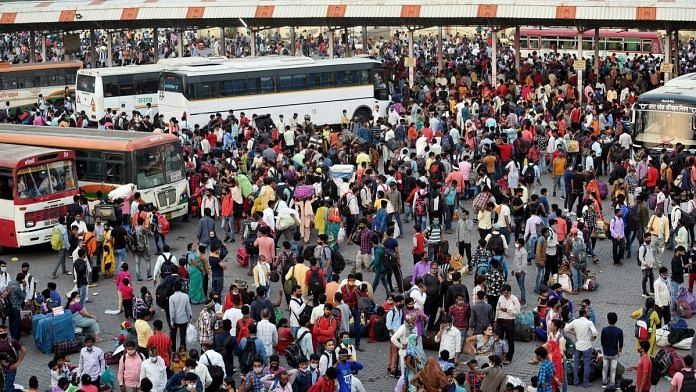New Delhi: The two-month-old national database of unorganised workers shows there could be gaps in the delivery of government subsidies to the bank accounts of the poor and vulnerable, the main beneficiaries of various welfare schemes such as Ujjwala and PM-Kisan.
According to information given by 5.29 crore unorganised sector workers who have registered on the e-SHRAM portal until Thursday, the bank accounts of 74.78 per cent or 3.9 crore workers aren’t linked with Aadhaar.
This comes despite the fact that all these workers have an Aadhaar number, without which one can’t register on the portal. Nearly 80 per cent informal sector workers registered on the portal have provided their bank account details.
While a Supreme Court order states that the government cannot deny services including rations to a beneficiary if she doesn’t have an Aadhaar number, the Prevention of Money-laundering (Maintenance of Records) Third Amendment Rules, 2019, clearly states otherwise.
The rules say that if one wishes to receive any benefit or subsidy under any scheme notified under section 7 of the Aadhaar (Targeted Delivery of Financial and Other subsidies, Benefits and Services) Act, 2016 (18 of 2016), it is mandatory to submit Aadhaar number to the banking service provider.
As on date, all government welfare schemes, be it LPG subsidy, PM Awas Yojana, or PM-Kisan Samman Nidhi Yojana, have been linked to the 12-digit unique identity number, with the aim to authenticate the identity of the beneficiary.
If bank accounts of beneficiaries aren’t linked to Aadhaar, they don’t get subsidies in their accounts and need to approach the concerned authorities directly for claiming benefits in a cumbersome process.
Till date, close to 74 crore bank accounts in the country have been linked to Aadhaar, according to officials in the Unique Identification Authority of India, the nodal agency for issuing Aadhaar numbers. As of January, there were 140 crore bank accounts in the country.
Also read: Modi govt clears empanelment of 27 IAS officers of 1990 batch for secretary-level posts
Labour ministry starts writing to banks
With the e-SHRAM portal throwing up such a large number of informal sector workers with bank accounts not linked to Aadhaar, the Union Ministry of Labour and Employment has now swung into action.
“The Directorate General Labour Welfare, which handles the e-SHRAM portal, has now started writing to individual banks where a worker has an account and directing them to ensure that their bank account is linked to Aadhaar. The process has already started,” said a senior labour ministry official who didn’t wish to be named.
The official said a decision was taken when the e-SHRAM portal was being set up that if there are instances of bank accounts not linked to Aadhaar, the ministry would write to the banks to ensure the process.
Once the registration process picks up pace, the government intends to link various welfare schemes with the portal. A worker would then be able to avail benefits of the schemes by registering and applying online.
The labour ministry, which runs the portal, intends to get over 38 crore informal sector workers in India registered by March 2022.
The portal details
The e-SHRAM portal provides details of the different social sector and welfare schemes run by the central and state governments targeting those in the unorganised sector.
It also captures details of unorganised sector workers such as their current employment status, skill type, family details, address, location (in case of migrant workers), and movement from formal to the informal sector.
The setting up of the national database was necessitated following the reverse migration that happened in the aftermath of the first wave of Covid-19 pandemic. It saw hundreds of thousands of informal sector workers heading home after losing their livelihoods because of the stringent lockdown.
At the time, the Modi government had announced a slew of welfare schemes including free ration and cash transfer. But many of those hit the hardest were deprived of the benefits as the government didn’t have details about their whereabouts, or even the data to identify the actual number of migrant workers in the country.
Also read: Govt defends criteria for EWS quota in jobs & education, likely to urge SC not to modify system






